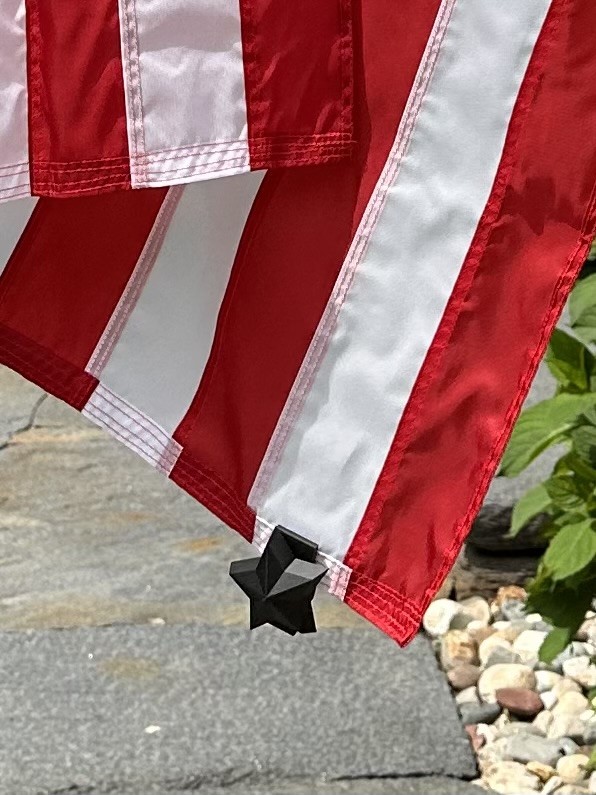Cooked Up Ideas and UMass ADDFab: Success Story
Cooking up a new product to keep flags neat
State-subsidized prototype of flag weight prevents twisting and tangling
Kimberly Cook, the founder of Cooked Up Ideas, was frustrated. Every time it got windy, she had to go outside and unwrap her flag from its pole. Fed up with flag-fixing, she started researching solutions. She couldn’t find anything that worked. She decided to create her own solution. Now, thanks to a FORGE connection to the University of Massachusetts Advanced Digital Design and Fabrication Lab, or ADDFab, Cook has a robust prototype of her flag weight and is on the journey to commercialization.
The path to a prototype

Cook initially worked with a product development firm in Pennsylvania to do patent research and flesh out her idea to keep flags from tangling. The company pitched her idea to other companies, but none of them wanted to buy. So Cook took the project into her own hands. She redesigned her idea and looked for help turning her drawings of a star-shaped weight to clip onto flags into a physical prototype.
Cook had consulted with FORGE in the early stages of her idea. Now that she’d redesigned, she came back for support. FORGE doesn’t connect innovators with manufacturers until they reach the prototype stage, but innovators without prototypes can access FORGE’s manufacturing readiness resources like workbooks and webinars.
“It was the perfect time to circle back,” Cook said. “I went to one of their virtual workshops about selecting a contract manufacturer. It was awesome!”
After the workshop, Cook asked FORGE for a connection to a manufacturer. FORGE linked her up with ADDFab. ADDFab is not your typical 3D printing vendor. In addition to being an additive manufacturing vendor, the company provides high-touch guidance and support for customers new to additive manufacturing. It’s also part of University of Massachusetts Amherst.
“We’re a UMass Amherst core facility – basically, a research lab for rent. People worry that accessing us will involve a difficult contracting process because we’re at a university, but we function like any other small business,” ADDFab director Dave Follette said. “If someone wants to use advanced equipment without buying it, they come to us.”
A FORGE connection to additive manufacturing bears fruit
Cook used a voucher program funded by the Massachusetts legislature, which provides 50-75 percent subsidies on UMass core facility services to companies with 50 or fewer employees. The voucher program gives small companies, like Cook’s sole proprietorship, the chance to try high-end technologies that would otherwise be too expensive.
A lot of those small companies find ADDFab through FORGE. Thanks to a long relationship with FORGE Vice President Adam Rodrigues, ADDFab has been involved with FORGE since its origins as an internal Greentown Labs project.
“Adam’s goal was to connect local startups and manufacturers,” Follette said. “He was very good at it and still is! There’s a steady stream of companies coming to us from FORGE.”
The customer referrals ADDFab gets from FORGE range from production runs of one or two prints to a run of 2,000 parts with 20-30 revisions. 3D printing is perfect for innovators at the early prototype stage who need an easy way to iteratively improve their designs.
Depending on a project’s complexity, ADDFab student interns do some or all of the work, providing them with the experience of working on additive manufacturing projects with real clients. For Cook’s flag weight, ADDFab intern Cade Lanzafame took the lead, turning Cook’s designs into a 3D model and printing a few trial versions before delivering a prototype.
“I have to give UMass so much credit,” Cook said. “They had all the programs to do the drawings, and the engineering smarts to solve the problem in the easiest way. I think it was Cade who figured out the last missing piece that perfected the design. This couldn’t have been a better experience for me!”
Looking forward: becoming the parchment paper of flags
With her ADDFab-made prototypes in hand, Cook is looking for larger-scale manufacturers and commercial customers. She’ll work with ADDFab to prepare the flag weight design for injection molding. And FORGE gave her several manufacturer referrals.
Cook said, “I could tell FORGE is well-respected because as soon as they made an email intro, the manufacturers immediately set up phone calls with me. These people are so busy, but seeing FORGE’s name made them reply instantly.”
In addition to mass production, Cook is looking into distribution and deciding whether to sell directly to consumers, sell to flag companies, or something else. She remembers her long-term goal every time she goes for a drive.
“Every time I’m out of the house, I see so many flags that are tangled up,” she said. “I want every town and every house to have my flag weight. It’s a simple thing, but it will keep the flags from ripping, keep them in better condition and make them look better. I think of my flag weight as being like parchment paper. Before parchment paper, things just stuck to your cookie sheets. Now everyone has it at home. We can’t imagine a world where we’d put up with stuck cookies. So why would you put up with a tangled flag?”
